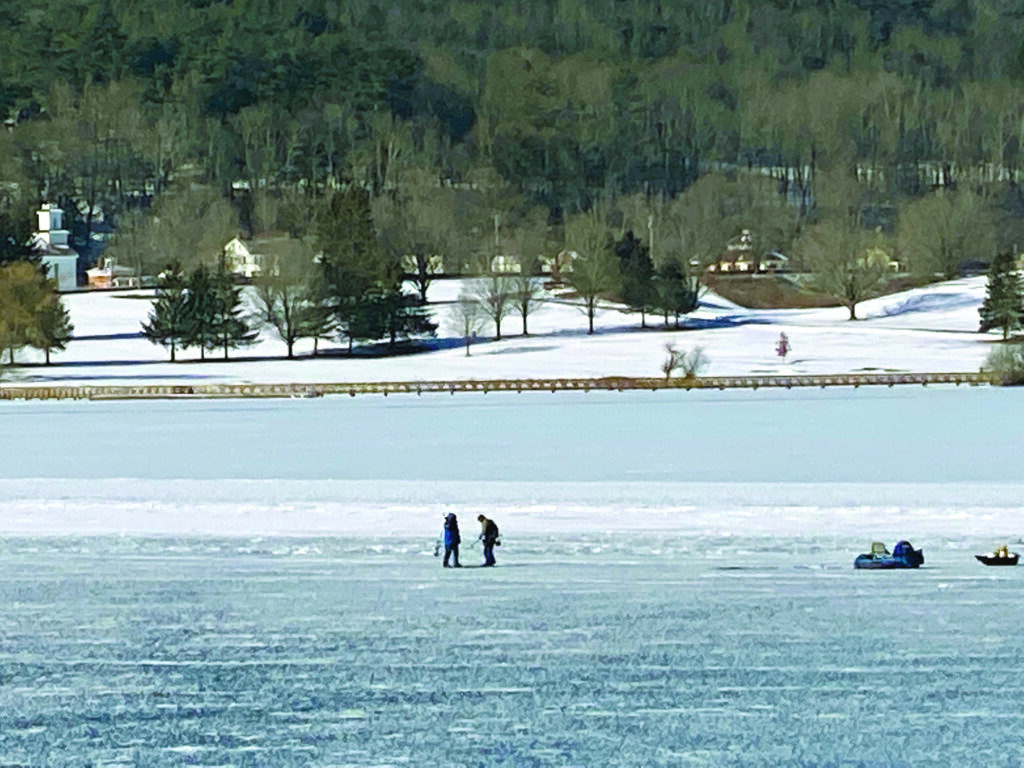
January’s chill lures fishers to Otsego ice, but is it too early?
By Ted Potrikus
Mid-January’s cold snap invited winter sports enthusiasts onto the ice covering the southeastern corner of Otsego Lake last weekend, amazing a few passersby who wondered about their safety.
“That’s as risky a behavior as I’ve ever seen for this time of year,” said Matt Albright, Assistant to the Director of the SUNY Oneonta Biological Field Station. “That ice couldn’t have been more than an inch thick.”
“It might be as early in the season as I’ve ever seen anyone out there,” he continued, noting he watched a pair of intrepid ice fishers as they stepped farther from the edge along the streets of the Lakeland Shores development. “I love ice fishing myself, but these guys must be really devoted to it!”
Field Station rules for its students require four inches of clear ice as the minimum for safe access, with “white, or old ice” requiring more thickness. “Old white ice can lose its integrity when six inches thick,” read the guidelines. SUNY also requires students to “test ice thickness every few feet with augur when first accessing open water.”
“Some people think four inches is overprotective,” Mr. Albright said. “Safety first for our students.”
“If I were to go out, I’m going five feet out and cut a hole to test the thickness,” he said. “If it’s good, I’ll go another five feet and cut another hole. If it looks decent, then I feel safe to be out there.”
SUNY’s ice data traces the lake back to the winter of 1849-50, showing a ‘freeze date’ of February 1, 1850 and a break-up date of April 24, 1850.
“The lake has frozen over every year since then except for three years,” Mr. Albright said. “Those three years all come in the last 20 years, which says something else altogether.”
A 2020 report from Field Station researcher Holly A. Waterfield, CLM, shows no freeze in the winters of 2001-02, 2011-12, and 2016-17. Available data show a freeze date of February 9, 2020 and break-up date only 40 days later (March 20, 2020).
The report shows a gradual declination in the duration of ice cover, writing, “Long-term trends in the duration of ice cover follow those exhibited by many lakes throughout the northern hemisphere. The rate of change in Otsego Lake’s length ice cover in more recent years (1960-2020) is greater than that seen from 1850-2020, based on a decade mean ice cover duration. The ecological effects of such changes are currently a focus of researchers around the world.”
Mr. Albright said Otsego Lake “is functionally frozen over” at this point, expecting the ice to deepen as January progresses.
The Field Station provides this guidance for its students: “Remember, there is no such thing as bad weather, only bad gear.” Mr. Albright stresses safety precautions for anyone heading out.
“There’s some really nice foul weather gear available now,” he said. “Float coats and suits that fit like overalls – from what I understand they work like a giant life vest that can keep a person afloat.”


I would like to contact the photographer of this photo, Ted Potrikus, to see if I can purchase a copy. I am fascinated by the perspective. I can see Crossroads Village with the church, pharmacy, tavern, carousel in the background. It looks like it’s very close to the lake when, in fact, it’s a long way from the lake shore. It’s an amazing, classic, iconic photo – taken by a drone??
Thanks!!
Harold Buckingham of Bloomfield, CT (but grew up in the Oneonta/Cooperstown area and love it!)
BuckinghamHarold@gmail.com